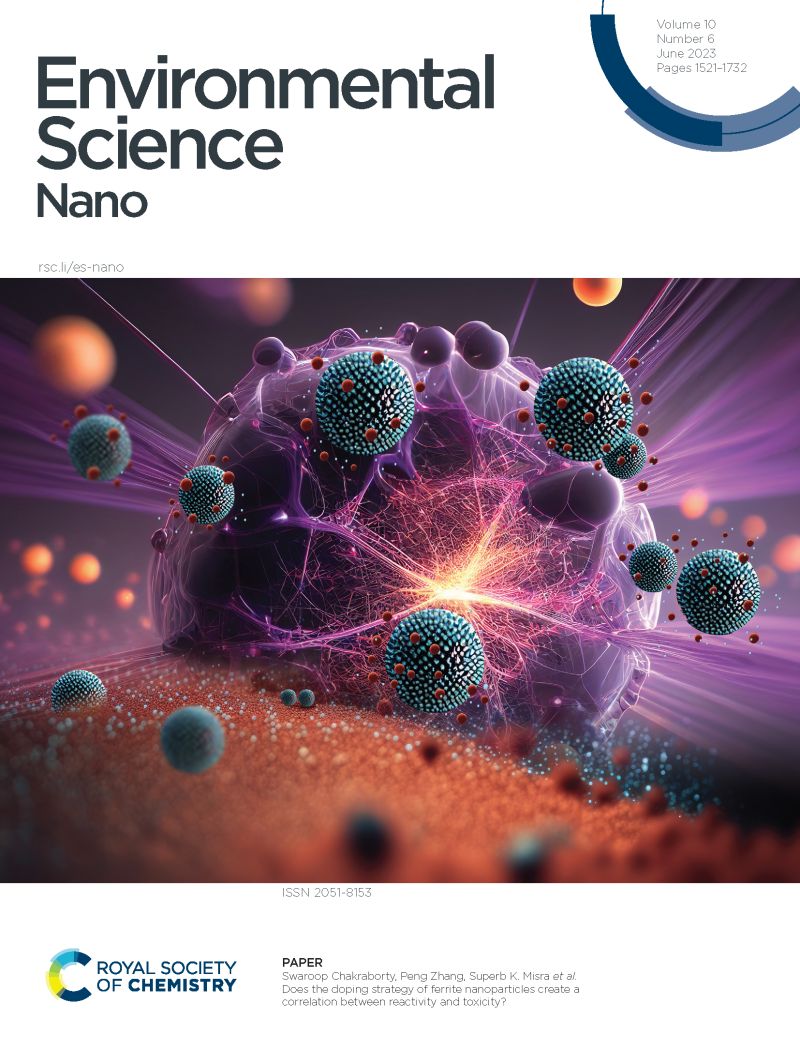植物源性rGO@ZnCo2O4尖晶石纳米结构用于太阳诱导的内分泌干扰物解毒:界面工程和电荷载流子调制
IF 5.1
2区 环境科学与生态学
Q1 CHEMISTRY, MULTIDISCIPLINARY
引用次数: 0
摘要
邻苯二甲酸酯(PAEs),如邻苯二甲酸二丁酯(DBP)和邻苯二甲酸苄丁酯(BBP),是普遍存在于水生环境中的增塑剂,具有严重的内分泌干扰和致癌风险。这项工作报告了一种可持续的方法,太阳能驱动的解毒PAEs使用植物性合成rGO@ZnCo2O4纳米复合材料。该复合材料采用绿色共沉淀法制备,采用印楝叶提取物,将还原氧化石墨烯与ZnCo2O4尖晶石框架集成在一起,以增强光吸收、表面反应性和载流子迁移率。结构、表面和光学分析证实了结晶尖晶石相的形成与氧化石墨烯的结合,产生了高表面积和窄带隙。电化学研究表明其具有较低的电荷转移阻力,而自由基猝灭实验表明•OH和O2•-是主要的氧化物质。在自然光照下,优化后的系统在模型溶液中可在180 min内降解97% DBP和96% BBP,在工业废水中去除率超过75%,TOC分析证实了大量矿化。LC-MS和GC-MS研究阐明了降解途径,表明转化为低毒性中间体。催化剂在9次循环中表现出优异的稳定性和可重复使用性,无结构降解。这些结果确立了rGO@ZnCo2O4作为下一代太阳能活性光催化剂的地位,它结合了绿色合成、卓越的稳定性和真实水的适用性,为可持续的、大规模的内分泌干扰污染物修复铺平了道路。本文章由计算机程序翻译,如有差异,请以英文原文为准。
Phytogenic rGO@ZnCo2O4 Spinel Nanoarchitecture for Solar-Induced Detoxification of Endocrine Disruptors: Interface Engineering and Charge Carrier Modulation
Phthalate esters (PAEs), such as dibutyl phthalate (DBP) and benzyl butyl phthalate (BBP), are ubiquitous plasticizers that persist in aquatic environments, posing severe endocrine-disrupting and carcinogenic risks. This work reports a sustainable approach for solar-driven detoxification of PAEs using a phytogenically synthesized rGO@ZnCo2O4 nanocomposite. The composite, fabricated via a green co-precipitation method employing Azadirachta indica leaf extract, integrates reduced graphene oxide with a ZnCo2O4 spinel framework to enhance light absorption, surface reactivity, and charge carrier mobility. Structural, surface and optical analyses confirmed the formation of a crystalline spinel phase with rGO incorporation, yielding a high surface area and a narrowed band gap. Electrochemical studies revealed low charge transfer resistance, while radical quenching experiments identified •OH and O2•‒ as primary oxidative species. Under natural sunlight, the optimized system achieved 97% DBP and 96% BBP degradation within 180 min in model solutions and over 75% removal in industrial wastewater, with substantial mineralization confirmed by TOC analysis. LC-MS and GC-MS investigations elucidated the degradation pathways, indicating transformation into low-toxicity intermediates. The catalyst exhibited excellent stability and reusability over nine cycles without structural degradation. These results establish rGO@ZnCo2O4 as a next-generation, solar-active photocatalyst that unites green synthesis, exceptional stability, and real-water applicability, paving the way for sustainable, large-scale remediation of endocrine-disrupting pollutants.
求助全文
通过发布文献求助,成功后即可免费获取论文全文。
去求助
来源期刊

Environmental Science: Nano
CHEMISTRY, MULTIDISCIPLINARY-ENVIRONMENTAL SCIENCES
CiteScore
12.20
自引率
5.50%
发文量
290
审稿时长
2.1 months
期刊介绍:
Environmental Science: Nano serves as a comprehensive and high-impact peer-reviewed source of information on the design and demonstration of engineered nanomaterials for environment-based applications. It also covers the interactions between engineered, natural, and incidental nanomaterials with biological and environmental systems. This scope includes, but is not limited to, the following topic areas:
Novel nanomaterial-based applications for water, air, soil, food, and energy sustainability
Nanomaterial interactions with biological systems and nanotoxicology
Environmental fate, reactivity, and transformations of nanoscale materials
Nanoscale processes in the environment
Sustainable nanotechnology including rational nanomaterial design, life cycle assessment, risk/benefit analysis
 求助内容:
求助内容: 应助结果提醒方式:
应助结果提醒方式:


